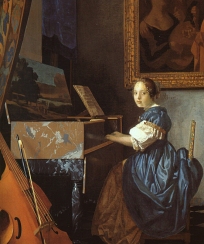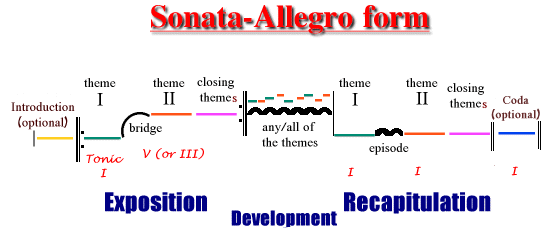|
Composers

Haydn

Mozart

Beethoven

Schubert

Brahms

Mendelssohn
|

Sonata
Among the most important forms
in instrumental music. A multi movement composition.
Its name originates in the Italian word "sonare" (to sound),
and it indicates its being different from the cantata sung by a human voices - its being an instrumental
form (played by instruments). The sonata turned from being a religious
form of 4 movements contrasted in character in the 16th century, to a well-defined
form in the classic era
sung by a human voices - its being an instrumental
form (played by instruments). The sonata turned from being a religious
form of 4 movements contrasted in character in the 16th century, to a well-defined
form in the classic era and later, usually played by one instrument
- the solo-sonata
(for a harpsichord
and later, usually played by one instrument
- the solo-sonata
(for a harpsichord ,
violin ,
violin etc.).
The first movement of the symphony
etc.).
The first movement of the symphony ,
designated for a grand orchestra, is written in the sonata form (also called
Sonata-Allegro ,
designated for a grand orchestra, is written in the sonata form (also called
Sonata-Allegro ),
and so is the concerto ),
and so is the concerto ,
designated for a solo instrument and an orchestra.
The father of the modern sonata
is Carl Philipp Emanuel Bach ,
designated for a solo instrument and an orchestra.
The father of the modern sonata
is Carl Philipp Emanuel Bach ,
son of the great J. S.Bach ,
son of the great J. S.Bach ,
who gave it its typical structure, and especially
its well-defined first movement - the sonata-allegro ,
who gave it its typical structure, and especially
its well-defined first movement - the sonata-allegro .
All great classical composers have written this way ever since, for different
ensembles. Haydn .
All great classical composers have written this way ever since, for different
ensembles. Haydn wrote many pieces in the sonata form, and
he is considered as the father of classic
symphony, and so was Mozart
wrote many pieces in the sonata form, and
he is considered as the father of classic
symphony, and so was Mozart .
In the Romantic .
In the Romantic age the prominent composers in this field
were Schubert
age the prominent composers in this field
were Schubert ,
Brahms ,
Brahms and Mendelssohn
and Mendelssohn .
Yet, and of even greater influence was Beethoven .
Yet, and of even greater influence was Beethoven ,
who added a forth movement, and made the sonata form his main means of
expression. His famous sonatas are the piano sonatas (the "Pathetique" ,
who added a forth movement, and made the sonata form his main means of
expression. His famous sonatas are the piano sonatas (the "Pathetique" ,
"Appassionata"
and "Moonlight" ,
"Appassionata"
and "Moonlight"  sonatas), the "Kreutzer" Sonata
for Violin and Piano; and of course, all his
symphonies incorporate
sonata movements. In all of his sonata movements, he expressed drama in
a musical way, articulated sensations in an unprecedented way, and introduced
bold harmonies.
sonatas), the "Kreutzer" Sonata
for Violin and Piano; and of course, all his
symphonies incorporate
sonata movements. In all of his sonata movements, he expressed drama in
a musical way, articulated sensations in an unprecedented way, and introduced
bold harmonies.
 In
the Romantic period, composers abandoned the strict formulas of sonata,
and gave their sonatas their own interpretation and structure, different
from the classic sonata; yet the sonata itself was still an important form
in the 20th century In
the Romantic period, composers abandoned the strict formulas of sonata,
and gave their sonatas their own interpretation and structure, different
from the classic sonata; yet the sonata itself was still an important form
in the 20th century ,
fixed and uniform as before. ,
fixed and uniform as before.
Sonata
Allegro
A form used for the first movements
of sonatas, symphonies, concertos, string quartet and other pieces,
consisting of three main sections : :
I. Exposition
II. Development
III. Recapitulation

 First Movement from Beethoven's
Sonata No.8 in Cm, Op.13 'Pathetique'
First Movement from Beethoven's
Sonata No.8 in Cm, Op.13 'Pathetique'
|
 Flute Sonata in F - Telemann
Flute Sonata in F - Telemann
|
 First Movement from Beethoven's 'Moonlight' Sonata
No.14 in C#m, Op.27 No.2
First Movement from Beethoven's 'Moonlight' Sonata
No.14 in C#m, Op.27 No.2
|
|
Xtend
 Listen
Listen
 Period
Period
 Scheme
Scheme
 Notes
Notes
 Dictionary
Dictionary
 Internet
Internet
 Projects
Projects
 Finders
Finders
|